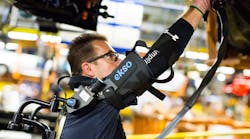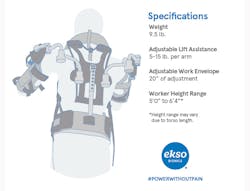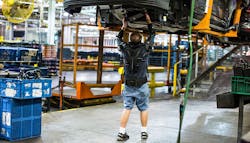In the distant past, automakers and the UAW didn't always agree on how best to reconcile worker welfare and plant profitability. But this is a new era of automobile manufacturing, one where the sun fuels cars, which drive themselves to chauffeur you around town. In short, things change.
Nothing illustrates this better than recent pilot programs at Ford's Michigan Assembly Plant and Flat Rock Plant, where the UAW-funded upper body exoskeletons were brought in to reduce shoulder injuries in overhead tasks, such as assembly of a Mustang's undercarriage.
"We've been calling the 'smile machine', because when people put it on for the first time, their arms just sort of float upwards and a big smile comes across their face,"' says Marty Smets, the technical expert for Ford's Human Systems and Virtual Manufacturing who spearheaded the ergonomics project.
Four workers donned separate Ekso Bionics 10-lb. EksoVest for the trial that began in May 2017. The exo-wearables reduce the weight of their power tools—and their own extremities— by five to 15 lbs. in each arm. Ford says these workers may have to repeat overhead tasks 4,600 times a day, or a million times annually, which can lead to costly surgeries and several months of missed time.
Through a system of hinges and non-electrical actuators, the vest reduces fatigue in the deltoids and rotator muscles.
According to the National Library of Medicine, a torn rotator cuff could cost on average $26,000 and take seven months to rehab.
"It's not high loads that cause these insidious injuries in soft tissues like the shoulder," says Smets. "It tends to be low loads that are repetitive. A low load in palm transfers to pretty high torque at shoulder."
Along with saving your employees from an arduous recovery process, the economics make sense for any worker performing repetitive overhead jobs.
"If you prevent one shoulder injury, you've paid for the device several times over," the biomechanics expert says.
The devices, which are constantly being refined on the fly based on Ford feedback, are expected to last five to seven million cycles, or at least two to three years. Prices vary based on order volume, but it could break down to around $100/month.
While Ford's employees didn't share the vests, as they are fitted to each worker and do get sweaty, Smets says for small companies, such as dry wallers, he thinks that would be possible.
The assembly workers spent up to 900 hours each validating the vest's efficacy. Before the trial, Smets gathered data on how often and where they felt discomfort. After wearing the vest, he says every worker reported a decrease in discomfort at the end of the work week.
Ekso Bionics, fittingly headquartered in an old Ford plant in Richmond, Calif., was chosen by the Ford workers after a three-day trial in March 2016. Other contenders were suitX, which makes the shoulderX, and Levitate, which manufactures the AIRFRAME.
Ekso Bionics, founded in 2005, had the most "prime-time ready" device, Smets says.
The Ekso Works line also makes the ZeroG tool holder, which attaches quickly to safety railing and acts as a support for heavy-duty destructive power tools. For one for drilling case study, productivity increased between 200% and 300%.
For the following three-day trial in August 2016, Smets focused on range of motion, balance, and thermal regulation (how hot it makes them), and 70% said they would wear it every shift and that it improved performance.
This is the just latest effort for Ford to improve its worker safety. Through various ergonomic initiatives, the auto maker has seen an 83% decline of missed time, work restrictions, or job transfers due to injuries since 2005.
One way this is done is through virtual manufacturing, where biomechanic experts use 3D-printed models, full-body motion capture, and virtual reality to optimize how its "industrial athletes" perform their tasks.
In 2011, Ford attempted an internal exoskeleton project, though Smets says the current project was more successful because it started by putting it on the backs of the operators.
And focusing on how the actual assemblers do their jobs is exactly how Henry Ford revolutionized manufacturing 100 years ago. It's also helped rewrite the "us-vs-them" stereotypes of unions and employers.
"When we can partner with the UAW and bring a health and safety solution to the plant floor and the workers can see it and physically experience the benefits it provides, it does a lot for trust building and to strengthen that relationship," Smets says.
Ford notes this partnership is just the most recent in a long stretch of working positively with the UAW.
"The health and safety of our membership has always been our highest priority," said UAW-Ford Vice President Jimmy Settles. "With the proven success at the piloted locations, we look forward to expanding this technology to our other UAW-Ford manufacturing facilities."
Ford's next goal is to expand the project to Europe and South America.
For now, the most important thing is that exoskeletons again have proven that for a minimal investment, they can greatly improve productivity and employee health.
"My job entails working over my head, so when I get home my back, neck and shoulders usually hurt," said Paul Collins, an assembly line worker at Ford's Michigan Assembly Plant. "Since I started using the vest, I'm not as sore, and I have more energy to play with my grandsons when I get home."













